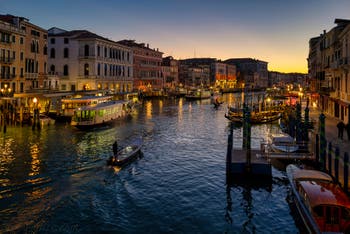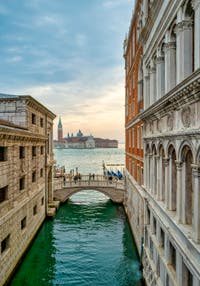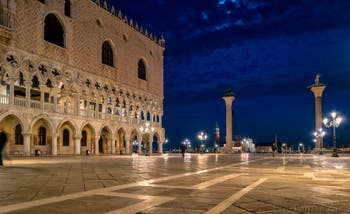History Important dates | Politics | Navy | Love | Wars | Religion | Scuole | Ghetto | Printing
Venice Maritime Republic and Queen of Commerce

The Grand Canal in Venice at night Surrounded by water, it was only natural that Venice quickly combined seafaring and trade, a combination that ensured the extraordinary development we know today.
From fishermen in the lagoon, the Venetians quickly became intrepid sailors, first around their home waters, then throughout the Adriatic and later in the Mediterranean.
Venetian merchant ships regularly sailed between the Mediterranean and the whole of southern and northern Europe: England, Spain, Portugal, France, the Netherlands, etc.
Some Venetians even ventured as far as Norway as early as 1431, with Pietro Querini's incredible journey to the Lofoten archipelago from Crete.
It is true that this was a shipwreck and that the destination was not planned.
Nevertheless, following the shipwreck, the destination was known and Querini's return journey to Venice shows us that many Venetians had already settled in "trading posts" in all the cities of northern Europe at that time.
Trade organised and planned by the Republic of Venice

The entrance to the Venice Arsenal In the beginning, maritime trade was mainly linked to spices, which were extremely valuable due to their low weight and high price, making the long and dangerous voyages of Venetian ships to the East profitable.
But it was also during this period that the Venetians' commercial genius came to the fore.
Trade was very well organised and planned by the Republic of Venice, with fleets rotating on fixed dates and in convoys.
This was particularly important given the insecurity that prevailed on the seas at the time.
Merchant ships were therefore not only protected by military vessels but were themselves equipped to face the enemy.

From the Bridge of Sighs Every Venetian sailor had a dual role. They could be rowers and soldiers at the same time if necessary.
To counteract weather-related problems, the first Venetian boats were both rowed and sailed.
This allowed them to continue moving forward in calm conditions, but it also helped protect the boats from pirates and other threats by making them more manoeuvrable during attacks and enabling them to take advantage of drops in wind speed to escape more quickly.
Galleys were paid and had a stake in the profits!
It is also important to note that the "galley slaves" of Venice were free men for a long time.They received a salary and also had the right to buy goods for themselves to resell at a profit in ports along the sea routes or in Venice upon their return.
This commercial solidarity between all members of the crew, from the most humble to the ship's captain, was also one of the key factors in the extraordinary growth of Venetian trade over so many centuries: everyone had a stake in the success of the expedition.
Venice, a hub between East and West
Finally, the Venetians very quickly succeeded in transforming the city of Venice into a veritable hub of trade between East and West.
Doge's Palace and Piazzetta San Marco Products from Northern Europe that were of interest to Eastern traders were sold in Venice, which then sold them on to the East, while Eastern products were transported to Germanic, French-speaking and English-speaking countries by Venetian ships.
This meant that the Venetians could make a profit on both the outward and return journeys, as no ship travelled empty. And woe betide anyone who did not pass through the port of Venice!
The Serenissima did not give much away to its competitors, which allowed it to pocket substantial taxes on passage.
It was this desire for absolute control over trade between East and West that was at the root of most of the wars between Venice and its neighbours, both near and far, including the sad and repeated wars between Venice and Genoa.
At sea but also on land
Venetian trade was not only maritime, far from it.The Venetians used land routes just as much as sea routes to obtain supplies or purchase products in Northern Europe and the East.
The two were often complementary. This is how the famous Marco Polo travelled to China by land in 1271, if one can use such terms for that era.
And Marco Polo, made famous by his Book of Marvels of the World or Il Milione, was not the only adventurous merchant from Venice.
Before and after him, many other Venetian merchants found wealth by travelling the world in search of rare and expensive goods.
Finally, travel also means cartography
Venice played a major role in the birth of a true science of geography, with famous cartographers who helped lay the foundations of modern cartography.Venice was renowned throughout Europe for its treatises on navigation and its art of cartography.
This art would never have flourished to such an extent or achieved such a high level of quality at the time without the impetus provided by Venetian trade, which enabled Venetian cartographers to obtain accurate and efficient information about the countries crossed by merchants.
History Important dates | Politics | Navy | Love | Wars | Religion | Scuole | Ghetto | Printing
Back to Top of Page

